Exploring the Impact of Future Technologies on Education
VerifiedAdded on 2020/04/21
|10
|2627
|51
Essay
AI Summary
The future of technology in education promises significant changes that can enhance learning experiences. With the integration of technologies such as cloud computing and 3D printing, educational environments are set to transform dramatically. These advancements offer immense opportunities for personalized learning and increased accessibility. However, they also pose challenges concerning equitable access and effective implementation. As technology becomes more embedded in education systems worldwide, stakeholders must navigate these changes carefully to maximize benefits while mitigating negative impacts. This essay explores both the promising potentials and critical considerations of future technologies in education, emphasizing a balanced approach to fostering innovation and inclusivity.
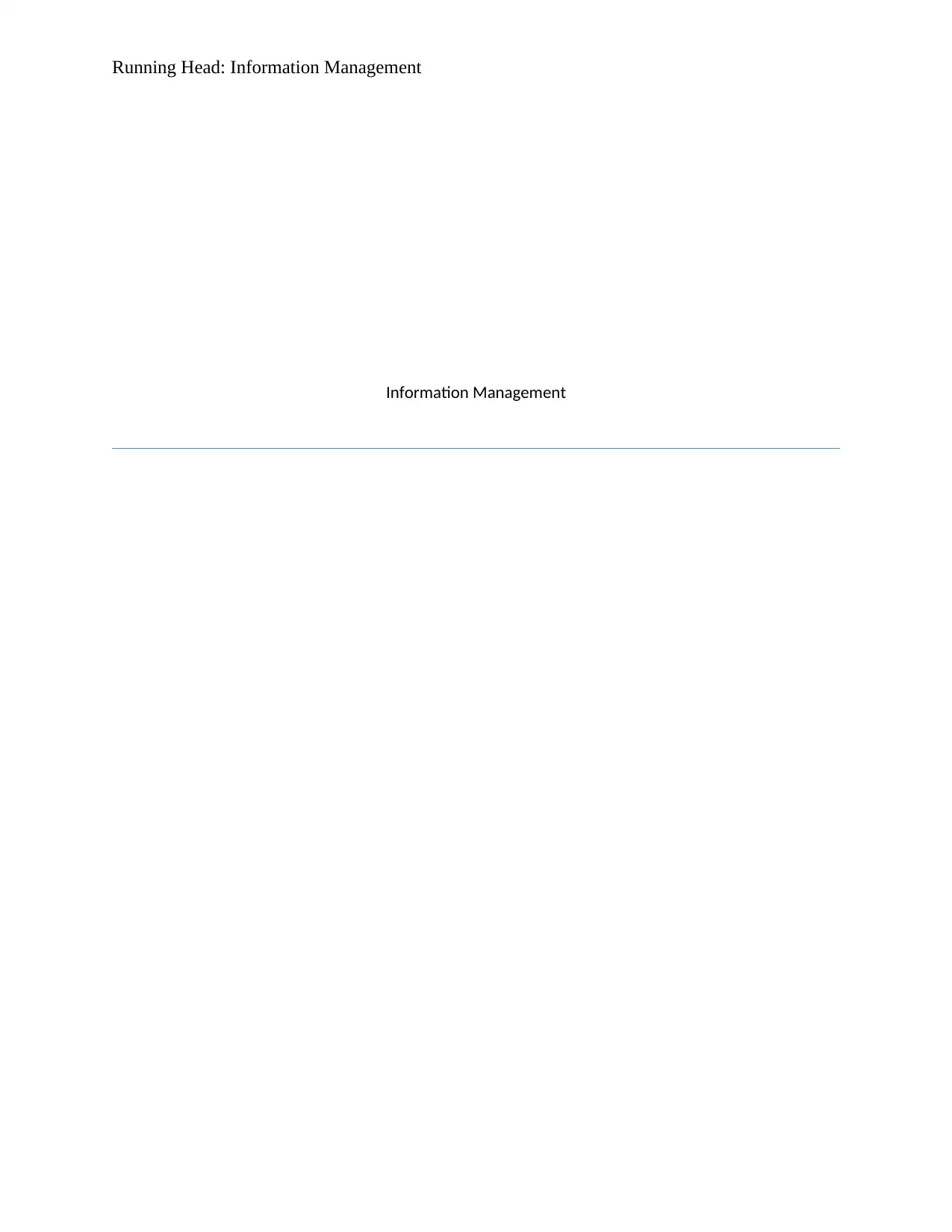
Running Head: Information Management
Information Management
Information Management
Paraphrase This Document
Need a fresh take? Get an instant paraphrase of this document with our AI Paraphraser
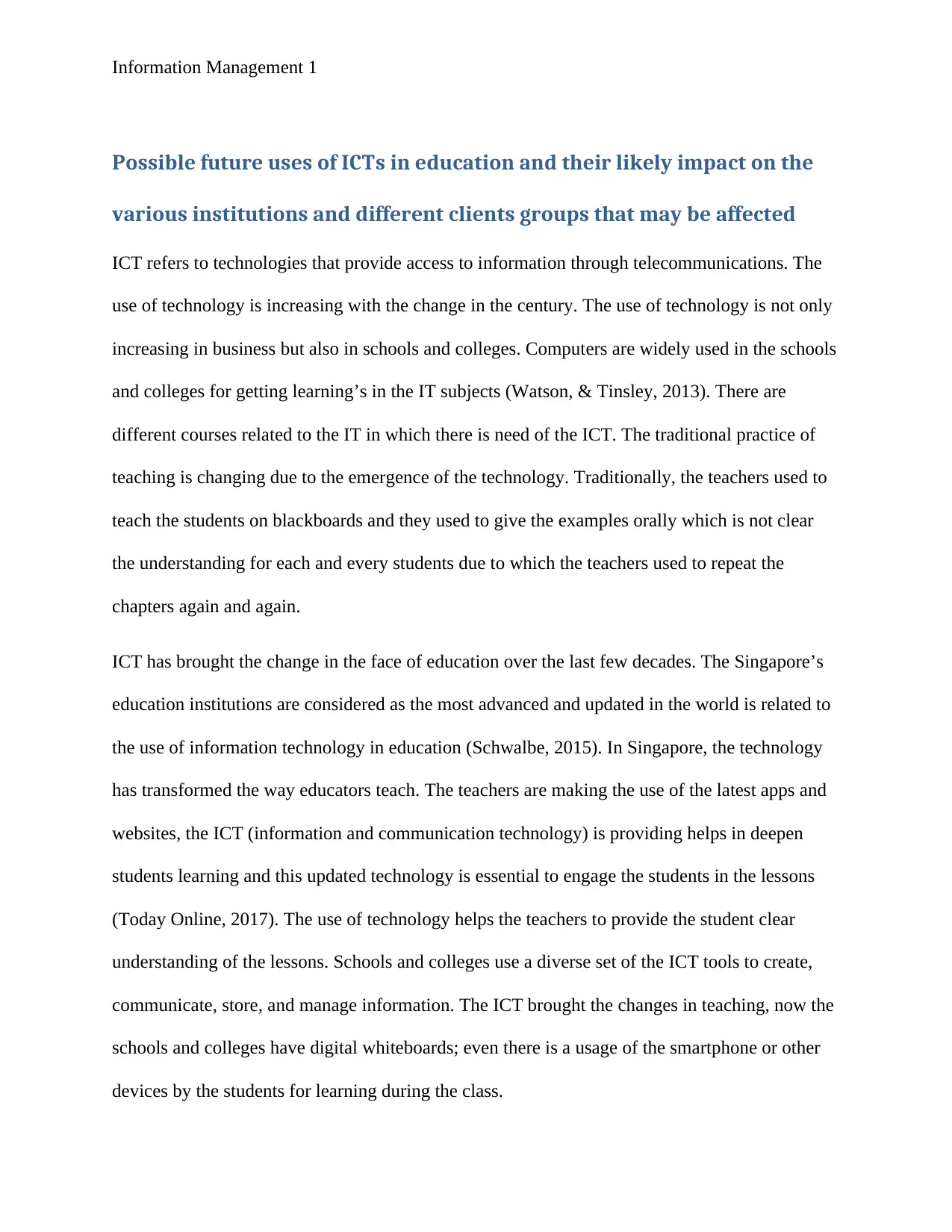
Information Management 1
Possible future uses of ICTs in education and their likely impact on the
various institutions and different clients groups that may be affected
ICT refers to technologies that provide access to information through telecommunications. The
use of technology is increasing with the change in the century. The use of technology is not only
increasing in business but also in schools and colleges. Computers are widely used in the schools
and colleges for getting learning’s in the IT subjects (Watson, & Tinsley, 2013). There are
different courses related to the IT in which there is need of the ICT. The traditional practice of
teaching is changing due to the emergence of the technology. Traditionally, the teachers used to
teach the students on blackboards and they used to give the examples orally which is not clear
the understanding for each and every students due to which the teachers used to repeat the
chapters again and again.
ICT has brought the change in the face of education over the last few decades. The Singapore’s
education institutions are considered as the most advanced and updated in the world is related to
the use of information technology in education (Schwalbe, 2015). In Singapore, the technology
has transformed the way educators teach. The teachers are making the use of the latest apps and
websites, the ICT (information and communication technology) is providing helps in deepen
students learning and this updated technology is essential to engage the students in the lessons
(Today Online, 2017). The use of technology helps the teachers to provide the student clear
understanding of the lessons. Schools and colleges use a diverse set of the ICT tools to create,
communicate, store, and manage information. The ICT brought the changes in teaching, now the
schools and colleges have digital whiteboards; even there is a usage of the smartphone or other
devices by the students for learning during the class.
Possible future uses of ICTs in education and their likely impact on the
various institutions and different clients groups that may be affected
ICT refers to technologies that provide access to information through telecommunications. The
use of technology is increasing with the change in the century. The use of technology is not only
increasing in business but also in schools and colleges. Computers are widely used in the schools
and colleges for getting learning’s in the IT subjects (Watson, & Tinsley, 2013). There are
different courses related to the IT in which there is need of the ICT. The traditional practice of
teaching is changing due to the emergence of the technology. Traditionally, the teachers used to
teach the students on blackboards and they used to give the examples orally which is not clear
the understanding for each and every students due to which the teachers used to repeat the
chapters again and again.
ICT has brought the change in the face of education over the last few decades. The Singapore’s
education institutions are considered as the most advanced and updated in the world is related to
the use of information technology in education (Schwalbe, 2015). In Singapore, the technology
has transformed the way educators teach. The teachers are making the use of the latest apps and
websites, the ICT (information and communication technology) is providing helps in deepen
students learning and this updated technology is essential to engage the students in the lessons
(Today Online, 2017). The use of technology helps the teachers to provide the student clear
understanding of the lessons. Schools and colleges use a diverse set of the ICT tools to create,
communicate, store, and manage information. The ICT brought the changes in teaching, now the
schools and colleges have digital whiteboards; even there is a usage of the smartphone or other
devices by the students for learning during the class.
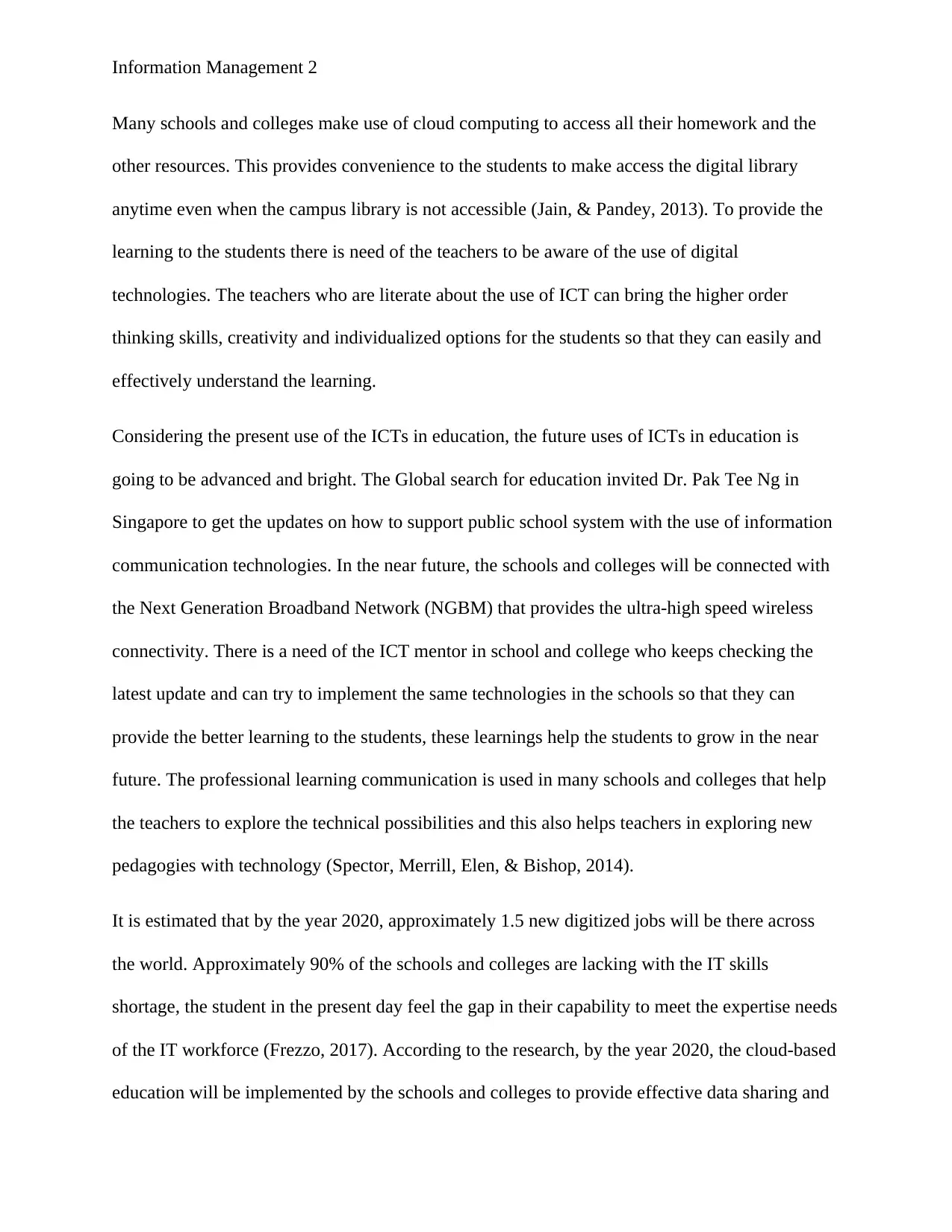
Information Management 2
Many schools and colleges make use of cloud computing to access all their homework and the
other resources. This provides convenience to the students to make access the digital library
anytime even when the campus library is not accessible (Jain, & Pandey, 2013). To provide the
learning to the students there is need of the teachers to be aware of the use of digital
technologies. The teachers who are literate about the use of ICT can bring the higher order
thinking skills, creativity and individualized options for the students so that they can easily and
effectively understand the learning.
Considering the present use of the ICTs in education, the future uses of ICTs in education is
going to be advanced and bright. The Global search for education invited Dr. Pak Tee Ng in
Singapore to get the updates on how to support public school system with the use of information
communication technologies. In the near future, the schools and colleges will be connected with
the Next Generation Broadband Network (NGBM) that provides the ultra-high speed wireless
connectivity. There is a need of the ICT mentor in school and college who keeps checking the
latest update and can try to implement the same technologies in the schools so that they can
provide the better learning to the students, these learnings help the students to grow in the near
future. The professional learning communication is used in many schools and colleges that help
the teachers to explore the technical possibilities and this also helps teachers in exploring new
pedagogies with technology (Spector, Merrill, Elen, & Bishop, 2014).
It is estimated that by the year 2020, approximately 1.5 new digitized jobs will be there across
the world. Approximately 90% of the schools and colleges are lacking with the IT skills
shortage, the student in the present day feel the gap in their capability to meet the expertise needs
of the IT workforce (Frezzo, 2017). According to the research, by the year 2020, the cloud-based
education will be implemented by the schools and colleges to provide effective data sharing and
Many schools and colleges make use of cloud computing to access all their homework and the
other resources. This provides convenience to the students to make access the digital library
anytime even when the campus library is not accessible (Jain, & Pandey, 2013). To provide the
learning to the students there is need of the teachers to be aware of the use of digital
technologies. The teachers who are literate about the use of ICT can bring the higher order
thinking skills, creativity and individualized options for the students so that they can easily and
effectively understand the learning.
Considering the present use of the ICTs in education, the future uses of ICTs in education is
going to be advanced and bright. The Global search for education invited Dr. Pak Tee Ng in
Singapore to get the updates on how to support public school system with the use of information
communication technologies. In the near future, the schools and colleges will be connected with
the Next Generation Broadband Network (NGBM) that provides the ultra-high speed wireless
connectivity. There is a need of the ICT mentor in school and college who keeps checking the
latest update and can try to implement the same technologies in the schools so that they can
provide the better learning to the students, these learnings help the students to grow in the near
future. The professional learning communication is used in many schools and colleges that help
the teachers to explore the technical possibilities and this also helps teachers in exploring new
pedagogies with technology (Spector, Merrill, Elen, & Bishop, 2014).
It is estimated that by the year 2020, approximately 1.5 new digitized jobs will be there across
the world. Approximately 90% of the schools and colleges are lacking with the IT skills
shortage, the student in the present day feel the gap in their capability to meet the expertise needs
of the IT workforce (Frezzo, 2017). According to the research, by the year 2020, the cloud-based
education will be implemented by the schools and colleges to provide effective data sharing and
⊘ This is a preview!⊘
Do you want full access?
Subscribe today to unlock all pages.

Trusted by 1+ million students worldwide
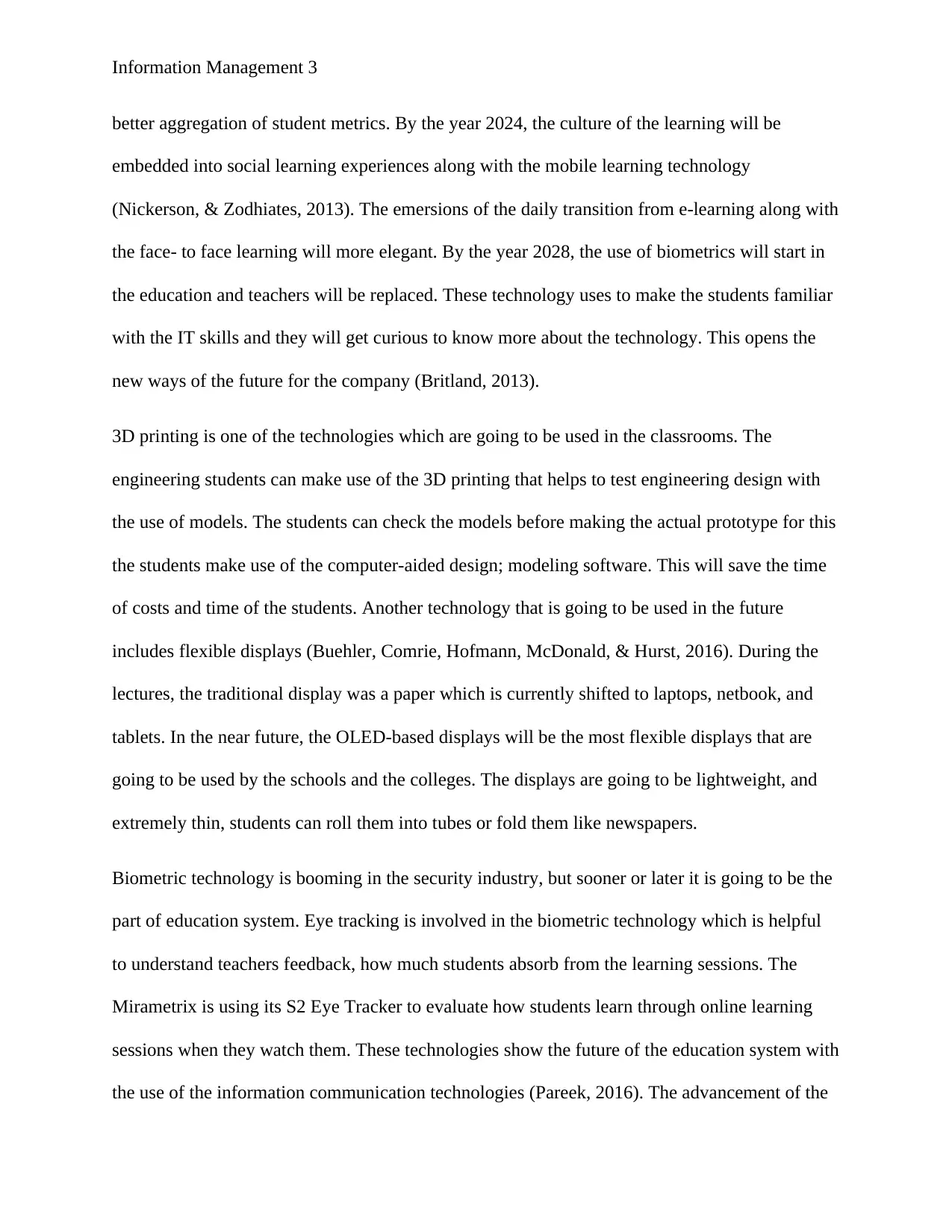
Information Management 3
better aggregation of student metrics. By the year 2024, the culture of the learning will be
embedded into social learning experiences along with the mobile learning technology
(Nickerson, & Zodhiates, 2013). The emersions of the daily transition from e-learning along with
the face- to face learning will more elegant. By the year 2028, the use of biometrics will start in
the education and teachers will be replaced. These technology uses to make the students familiar
with the IT skills and they will get curious to know more about the technology. This opens the
new ways of the future for the company (Britland, 2013).
3D printing is one of the technologies which are going to be used in the classrooms. The
engineering students can make use of the 3D printing that helps to test engineering design with
the use of models. The students can check the models before making the actual prototype for this
the students make use of the computer-aided design; modeling software. This will save the time
of costs and time of the students. Another technology that is going to be used in the future
includes flexible displays (Buehler, Comrie, Hofmann, McDonald, & Hurst, 2016). During the
lectures, the traditional display was a paper which is currently shifted to laptops, netbook, and
tablets. In the near future, the OLED-based displays will be the most flexible displays that are
going to be used by the schools and the colleges. The displays are going to be lightweight, and
extremely thin, students can roll them into tubes or fold them like newspapers.
Biometric technology is booming in the security industry, but sooner or later it is going to be the
part of education system. Eye tracking is involved in the biometric technology which is helpful
to understand teachers feedback, how much students absorb from the learning sessions. The
Mirametrix is using its S2 Eye Tracker to evaluate how students learn through online learning
sessions when they watch them. These technologies show the future of the education system with
the use of the information communication technologies (Pareek, 2016). The advancement of the
better aggregation of student metrics. By the year 2024, the culture of the learning will be
embedded into social learning experiences along with the mobile learning technology
(Nickerson, & Zodhiates, 2013). The emersions of the daily transition from e-learning along with
the face- to face learning will more elegant. By the year 2028, the use of biometrics will start in
the education and teachers will be replaced. These technology uses to make the students familiar
with the IT skills and they will get curious to know more about the technology. This opens the
new ways of the future for the company (Britland, 2013).
3D printing is one of the technologies which are going to be used in the classrooms. The
engineering students can make use of the 3D printing that helps to test engineering design with
the use of models. The students can check the models before making the actual prototype for this
the students make use of the computer-aided design; modeling software. This will save the time
of costs and time of the students. Another technology that is going to be used in the future
includes flexible displays (Buehler, Comrie, Hofmann, McDonald, & Hurst, 2016). During the
lectures, the traditional display was a paper which is currently shifted to laptops, netbook, and
tablets. In the near future, the OLED-based displays will be the most flexible displays that are
going to be used by the schools and the colleges. The displays are going to be lightweight, and
extremely thin, students can roll them into tubes or fold them like newspapers.
Biometric technology is booming in the security industry, but sooner or later it is going to be the
part of education system. Eye tracking is involved in the biometric technology which is helpful
to understand teachers feedback, how much students absorb from the learning sessions. The
Mirametrix is using its S2 Eye Tracker to evaluate how students learn through online learning
sessions when they watch them. These technologies show the future of the education system with
the use of the information communication technologies (Pareek, 2016). The advancement of the
Paraphrase This Document
Need a fresh take? Get an instant paraphrase of this document with our AI Paraphraser
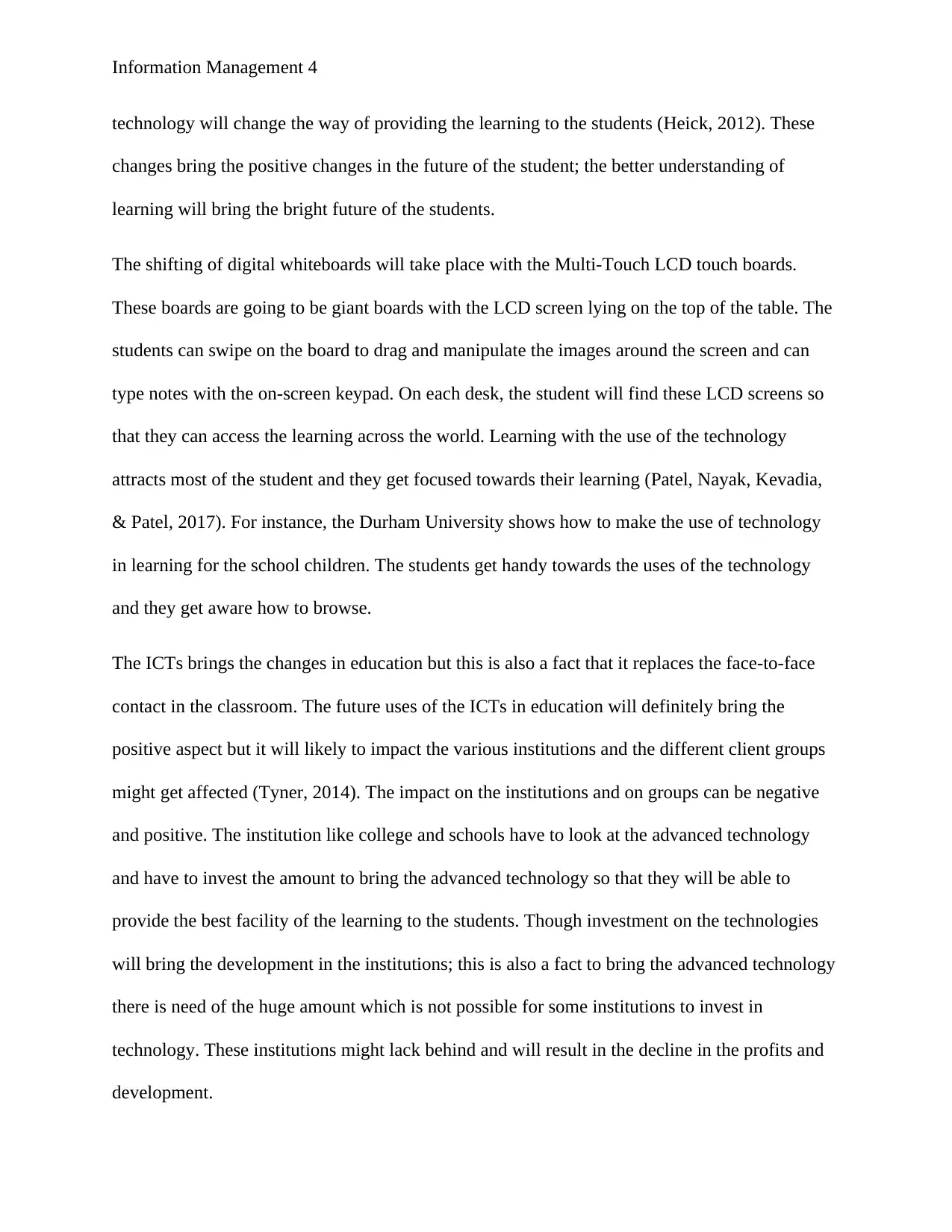
Information Management 4
technology will change the way of providing the learning to the students (Heick, 2012). These
changes bring the positive changes in the future of the student; the better understanding of
learning will bring the bright future of the students.
The shifting of digital whiteboards will take place with the Multi-Touch LCD touch boards.
These boards are going to be giant boards with the LCD screen lying on the top of the table. The
students can swipe on the board to drag and manipulate the images around the screen and can
type notes with the on-screen keypad. On each desk, the student will find these LCD screens so
that they can access the learning across the world. Learning with the use of the technology
attracts most of the student and they get focused towards their learning (Patel, Nayak, Kevadia,
& Patel, 2017). For instance, the Durham University shows how to make the use of technology
in learning for the school children. The students get handy towards the uses of the technology
and they get aware how to browse.
The ICTs brings the changes in education but this is also a fact that it replaces the face-to-face
contact in the classroom. The future uses of the ICTs in education will definitely bring the
positive aspect but it will likely to impact the various institutions and the different client groups
might get affected (Tyner, 2014). The impact on the institutions and on groups can be negative
and positive. The institution like college and schools have to look at the advanced technology
and have to invest the amount to bring the advanced technology so that they will be able to
provide the best facility of the learning to the students. Though investment on the technologies
will bring the development in the institutions; this is also a fact to bring the advanced technology
there is need of the huge amount which is not possible for some institutions to invest in
technology. These institutions might lack behind and will result in the decline in the profits and
development.
technology will change the way of providing the learning to the students (Heick, 2012). These
changes bring the positive changes in the future of the student; the better understanding of
learning will bring the bright future of the students.
The shifting of digital whiteboards will take place with the Multi-Touch LCD touch boards.
These boards are going to be giant boards with the LCD screen lying on the top of the table. The
students can swipe on the board to drag and manipulate the images around the screen and can
type notes with the on-screen keypad. On each desk, the student will find these LCD screens so
that they can access the learning across the world. Learning with the use of the technology
attracts most of the student and they get focused towards their learning (Patel, Nayak, Kevadia,
& Patel, 2017). For instance, the Durham University shows how to make the use of technology
in learning for the school children. The students get handy towards the uses of the technology
and they get aware how to browse.
The ICTs brings the changes in education but this is also a fact that it replaces the face-to-face
contact in the classroom. The future uses of the ICTs in education will definitely bring the
positive aspect but it will likely to impact the various institutions and the different client groups
might get affected (Tyner, 2014). The impact on the institutions and on groups can be negative
and positive. The institution like college and schools have to look at the advanced technology
and have to invest the amount to bring the advanced technology so that they will be able to
provide the best facility of the learning to the students. Though investment on the technologies
will bring the development in the institutions; this is also a fact to bring the advanced technology
there is need of the huge amount which is not possible for some institutions to invest in
technology. These institutions might lack behind and will result in the decline in the profits and
development.
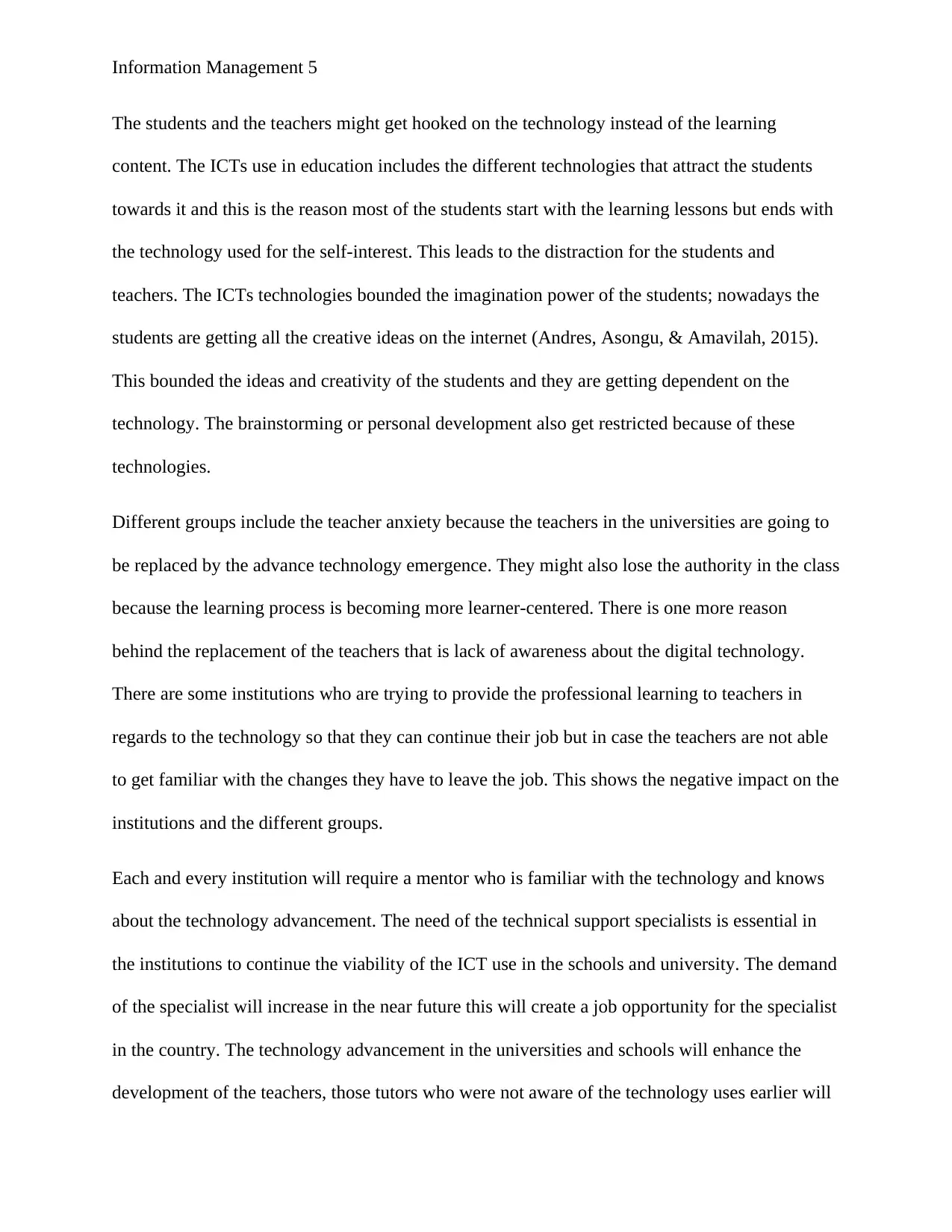
Information Management 5
The students and the teachers might get hooked on the technology instead of the learning
content. The ICTs use in education includes the different technologies that attract the students
towards it and this is the reason most of the students start with the learning lessons but ends with
the technology used for the self-interest. This leads to the distraction for the students and
teachers. The ICTs technologies bounded the imagination power of the students; nowadays the
students are getting all the creative ideas on the internet (Andres, Asongu, & Amavilah, 2015).
This bounded the ideas and creativity of the students and they are getting dependent on the
technology. The brainstorming or personal development also get restricted because of these
technologies.
Different groups include the teacher anxiety because the teachers in the universities are going to
be replaced by the advance technology emergence. They might also lose the authority in the class
because the learning process is becoming more learner-centered. There is one more reason
behind the replacement of the teachers that is lack of awareness about the digital technology.
There are some institutions who are trying to provide the professional learning to teachers in
regards to the technology so that they can continue their job but in case the teachers are not able
to get familiar with the changes they have to leave the job. This shows the negative impact on the
institutions and the different groups.
Each and every institution will require a mentor who is familiar with the technology and knows
about the technology advancement. The need of the technical support specialists is essential in
the institutions to continue the viability of the ICT use in the schools and university. The demand
of the specialist will increase in the near future this will create a job opportunity for the specialist
in the country. The technology advancement in the universities and schools will enhance the
development of the teachers, those tutors who were not aware of the technology uses earlier will
The students and the teachers might get hooked on the technology instead of the learning
content. The ICTs use in education includes the different technologies that attract the students
towards it and this is the reason most of the students start with the learning lessons but ends with
the technology used for the self-interest. This leads to the distraction for the students and
teachers. The ICTs technologies bounded the imagination power of the students; nowadays the
students are getting all the creative ideas on the internet (Andres, Asongu, & Amavilah, 2015).
This bounded the ideas and creativity of the students and they are getting dependent on the
technology. The brainstorming or personal development also get restricted because of these
technologies.
Different groups include the teacher anxiety because the teachers in the universities are going to
be replaced by the advance technology emergence. They might also lose the authority in the class
because the learning process is becoming more learner-centered. There is one more reason
behind the replacement of the teachers that is lack of awareness about the digital technology.
There are some institutions who are trying to provide the professional learning to teachers in
regards to the technology so that they can continue their job but in case the teachers are not able
to get familiar with the changes they have to leave the job. This shows the negative impact on the
institutions and the different groups.
Each and every institution will require a mentor who is familiar with the technology and knows
about the technology advancement. The need of the technical support specialists is essential in
the institutions to continue the viability of the ICT use in the schools and university. The demand
of the specialist will increase in the near future this will create a job opportunity for the specialist
in the country. The technology advancement in the universities and schools will enhance the
development of the teachers, those tutors who were not aware of the technology uses earlier will
⊘ This is a preview!⊘
Do you want full access?
Subscribe today to unlock all pages.

Trusted by 1+ million students worldwide
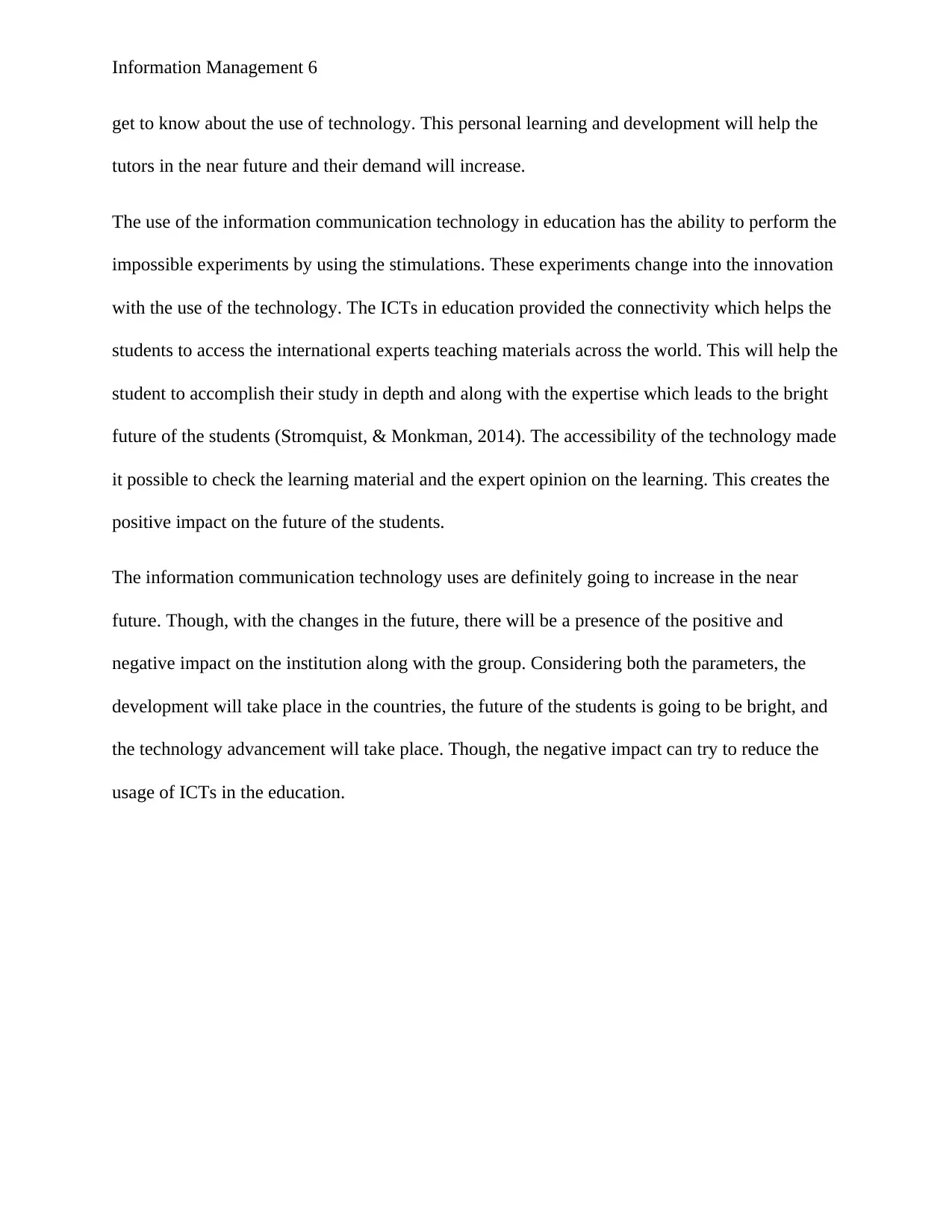
Information Management 6
get to know about the use of technology. This personal learning and development will help the
tutors in the near future and their demand will increase.
The use of the information communication technology in education has the ability to perform the
impossible experiments by using the stimulations. These experiments change into the innovation
with the use of the technology. The ICTs in education provided the connectivity which helps the
students to access the international experts teaching materials across the world. This will help the
student to accomplish their study in depth and along with the expertise which leads to the bright
future of the students (Stromquist, & Monkman, 2014). The accessibility of the technology made
it possible to check the learning material and the expert opinion on the learning. This creates the
positive impact on the future of the students.
The information communication technology uses are definitely going to increase in the near
future. Though, with the changes in the future, there will be a presence of the positive and
negative impact on the institution along with the group. Considering both the parameters, the
development will take place in the countries, the future of the students is going to be bright, and
the technology advancement will take place. Though, the negative impact can try to reduce the
usage of ICTs in the education.
get to know about the use of technology. This personal learning and development will help the
tutors in the near future and their demand will increase.
The use of the information communication technology in education has the ability to perform the
impossible experiments by using the stimulations. These experiments change into the innovation
with the use of the technology. The ICTs in education provided the connectivity which helps the
students to access the international experts teaching materials across the world. This will help the
student to accomplish their study in depth and along with the expertise which leads to the bright
future of the students (Stromquist, & Monkman, 2014). The accessibility of the technology made
it possible to check the learning material and the expert opinion on the learning. This creates the
positive impact on the future of the students.
The information communication technology uses are definitely going to increase in the near
future. Though, with the changes in the future, there will be a presence of the positive and
negative impact on the institution along with the group. Considering both the parameters, the
development will take place in the countries, the future of the students is going to be bright, and
the technology advancement will take place. Though, the negative impact can try to reduce the
usage of ICTs in the education.
Paraphrase This Document
Need a fresh take? Get an instant paraphrase of this document with our AI Paraphraser
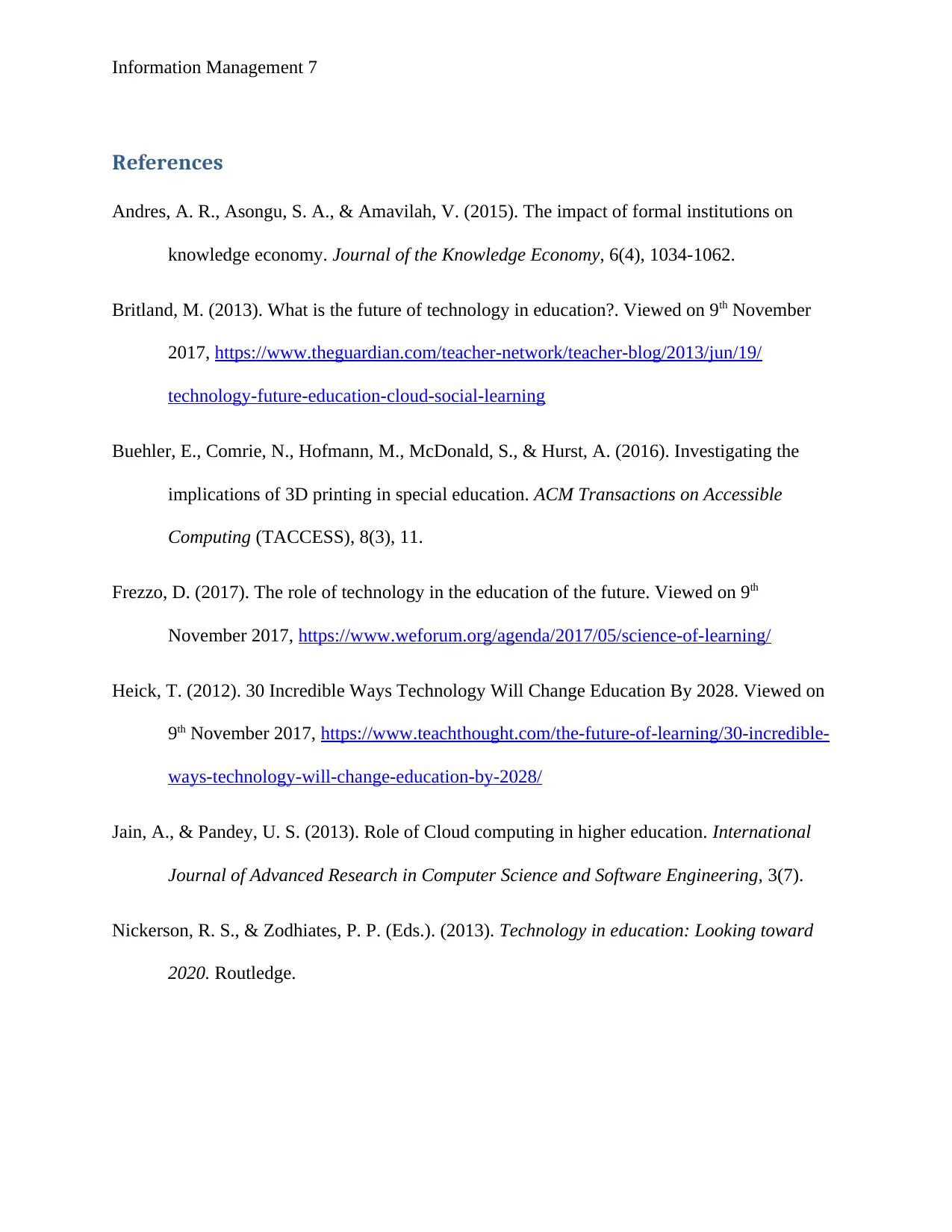
Information Management 7
References
Andres, A. R., Asongu, S. A., & Amavilah, V. (2015). The impact of formal institutions on
knowledge economy. Journal of the Knowledge Economy, 6(4), 1034-1062.
Britland, M. (2013). What is the future of technology in education?. Viewed on 9th November
2017, https://www.theguardian.com/teacher-network/teacher-blog/2013/jun/19/
technology-future-education-cloud-social-learning
Buehler, E., Comrie, N., Hofmann, M., McDonald, S., & Hurst, A. (2016). Investigating the
implications of 3D printing in special education. ACM Transactions on Accessible
Computing (TACCESS), 8(3), 11.
Frezzo, D. (2017). The role of technology in the education of the future. Viewed on 9th
November 2017, https://www.weforum.org/agenda/2017/05/science-of-learning/
Heick, T. (2012). 30 Incredible Ways Technology Will Change Education By 2028. Viewed on
9th November 2017, https://www.teachthought.com/the-future-of-learning/30-incredible-
ways-technology-will-change-education-by-2028/
Jain, A., & Pandey, U. S. (2013). Role of Cloud computing in higher education. International
Journal of Advanced Research in Computer Science and Software Engineering, 3(7).
Nickerson, R. S., & Zodhiates, P. P. (Eds.). (2013). Technology in education: Looking toward
2020. Routledge.
References
Andres, A. R., Asongu, S. A., & Amavilah, V. (2015). The impact of formal institutions on
knowledge economy. Journal of the Knowledge Economy, 6(4), 1034-1062.
Britland, M. (2013). What is the future of technology in education?. Viewed on 9th November
2017, https://www.theguardian.com/teacher-network/teacher-blog/2013/jun/19/
technology-future-education-cloud-social-learning
Buehler, E., Comrie, N., Hofmann, M., McDonald, S., & Hurst, A. (2016). Investigating the
implications of 3D printing in special education. ACM Transactions on Accessible
Computing (TACCESS), 8(3), 11.
Frezzo, D. (2017). The role of technology in the education of the future. Viewed on 9th
November 2017, https://www.weforum.org/agenda/2017/05/science-of-learning/
Heick, T. (2012). 30 Incredible Ways Technology Will Change Education By 2028. Viewed on
9th November 2017, https://www.teachthought.com/the-future-of-learning/30-incredible-
ways-technology-will-change-education-by-2028/
Jain, A., & Pandey, U. S. (2013). Role of Cloud computing in higher education. International
Journal of Advanced Research in Computer Science and Software Engineering, 3(7).
Nickerson, R. S., & Zodhiates, P. P. (Eds.). (2013). Technology in education: Looking toward
2020. Routledge.
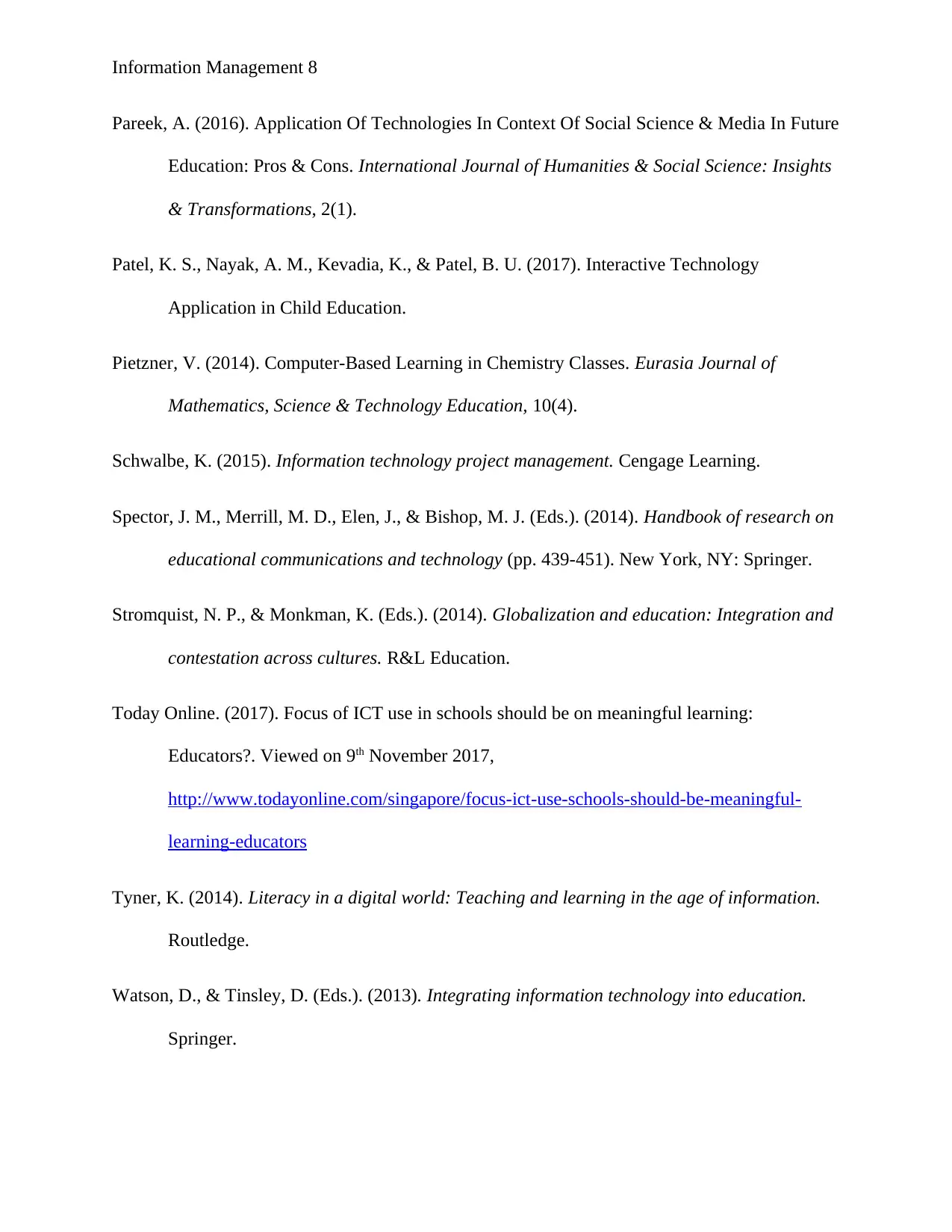
Information Management 8
Pareek, A. (2016). Application Of Technologies In Context Of Social Science & Media In Future
Education: Pros & Cons. International Journal of Humanities & Social Science: Insights
& Transformations, 2(1).
Patel, K. S., Nayak, A. M., Kevadia, K., & Patel, B. U. (2017). Interactive Technology
Application in Child Education.
Pietzner, V. (2014). Computer-Based Learning in Chemistry Classes. Eurasia Journal of
Mathematics, Science & Technology Education, 10(4).
Schwalbe, K. (2015). Information technology project management. Cengage Learning.
Spector, J. M., Merrill, M. D., Elen, J., & Bishop, M. J. (Eds.). (2014). Handbook of research on
educational communications and technology (pp. 439-451). New York, NY: Springer.
Stromquist, N. P., & Monkman, K. (Eds.). (2014). Globalization and education: Integration and
contestation across cultures. R&L Education.
Today Online. (2017). Focus of ICT use in schools should be on meaningful learning:
Educators?. Viewed on 9th November 2017,
http://www.todayonline.com/singapore/focus-ict-use-schools-should-be-meaningful-
learning-educators
Tyner, K. (2014). Literacy in a digital world: Teaching and learning in the age of information.
Routledge.
Watson, D., & Tinsley, D. (Eds.). (2013). Integrating information technology into education.
Springer.
Pareek, A. (2016). Application Of Technologies In Context Of Social Science & Media In Future
Education: Pros & Cons. International Journal of Humanities & Social Science: Insights
& Transformations, 2(1).
Patel, K. S., Nayak, A. M., Kevadia, K., & Patel, B. U. (2017). Interactive Technology
Application in Child Education.
Pietzner, V. (2014). Computer-Based Learning in Chemistry Classes. Eurasia Journal of
Mathematics, Science & Technology Education, 10(4).
Schwalbe, K. (2015). Information technology project management. Cengage Learning.
Spector, J. M., Merrill, M. D., Elen, J., & Bishop, M. J. (Eds.). (2014). Handbook of research on
educational communications and technology (pp. 439-451). New York, NY: Springer.
Stromquist, N. P., & Monkman, K. (Eds.). (2014). Globalization and education: Integration and
contestation across cultures. R&L Education.
Today Online. (2017). Focus of ICT use in schools should be on meaningful learning:
Educators?. Viewed on 9th November 2017,
http://www.todayonline.com/singapore/focus-ict-use-schools-should-be-meaningful-
learning-educators
Tyner, K. (2014). Literacy in a digital world: Teaching and learning in the age of information.
Routledge.
Watson, D., & Tinsley, D. (Eds.). (2013). Integrating information technology into education.
Springer.
⊘ This is a preview!⊘
Do you want full access?
Subscribe today to unlock all pages.

Trusted by 1+ million students worldwide

Information Management 9
1 out of 10
Related Documents
Your All-in-One AI-Powered Toolkit for Academic Success.
+13062052269
info@desklib.com
Available 24*7 on WhatsApp / Email
![[object Object]](/_next/static/media/star-bottom.7253800d.svg)
Unlock your academic potential
Copyright © 2020–2025 A2Z Services. All Rights Reserved. Developed and managed by ZUCOL.



